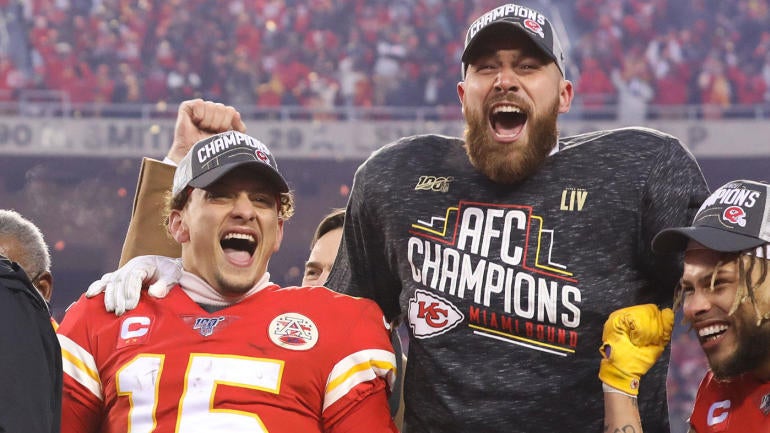
"Can't keep everyone" was All-Pro linebacker Bobby Wagner's brutally honest assessment of the Seahawks' salary cap situation after quarterback Russell Wilson signed his first big contract extension in 2015. Wagner's words seemed like they would ring true for the Chiefs at the end of last March when the Super Bowl LIV champions had only $177 of cap space.
The Chiefs are positioned to have an extended championship window thanks to the efforts of director of football administration Brandt Tilis, who is Kansas City's lead negotiator of player contracts and primarily responsible for managing the salary cap. Tilis had an extremely busy offseason in keeping core players by signing defensive tackle Chris Jones, quarterback Patrick Mahomes and tight end Travis Kelce to extensions.
Mahomes received the richest contract in American team sports history last July. The 2018 NFL MVP signed a 10-year, $450 million extension worth up to $500 million with incentives, which includes a no-trade clause.
Mahomes becoming the NFL's highest-paid player was expected. But nobody was anticipating the type of unconventional deal he signed. The tendency with lucrative quarterback contracts in recent years has been shorter deals. Prior to Mahomes, the five-year extension Matt Ryan signed with the Falcons in 2018 was the longest contract among the league's highest-paid quarterbacks. Extremely long quarterback deals had fallen out of favor by the middle of the 2000s. The longest NFL contract currently in existence -- outside of Mahomes' deal -- is the eight-year extension Tyron Smith signed with the Cowboys in 2014 to become the NFL's highest-paid offensive tackle.
The Chiefs have achieved something that sets them apart from other NFL teams with Mahomes' contract: Cost certainty with a top talent for an inordinate amount time. Mahomes' contract runs through the 2031 season.
To entice Mahomes to take such a lengthy deal, the Chiefs had to provide protections that typically don't exist during the later years of NFL contracts. Ordinarily in lengthy contracts, the later years are essentially a series of one-year options where teams can release players when it best suits them.
A significant amount of Mahomes' compensation each year is in March roster bonuses that become fully guaranteed at least one year early. For example, Mahomes' 2027 compensation consists of a $10 million base salary, a $49.4 million roster bonus due the third day of the league year, and a $550,000 workout bonus. The $49.4 million roster bonus becomes fully guaranteed on the third day of the 2026 league year. The base salary and workout bonus are fully guaranteed on the third day of the 2027 league year. The Chiefs would have to buy Mahomes out for $49.4 million to exit his deal in 2027 before the remaining $10.55 million became secure.
Mahomes' 2026 contract year operates in the same manner, so the Chiefs will be on the hook for his 2026 $38.9 million roster bonus on the third day of the 2025 league year. All of the latter years in Mahomes' contract are like this.
Over 80% of the $59.5 million Mahomes is scheduled to make in 2027 becomes secure a year in advance. After 2028, the percentage of Mahomes' compensation in a March roster bonus starts decreasing significantly. By 2031, the final year of the contract, the percentage of compensation in a roster bonus is less than 30%.
This structure with the annual roster bonuses vesting early is going to make it hard for the Chiefs to cut Mahomes during the bulk of his contract without incurring some major salary cap hit to part ways with him.
The Chiefs maintained short-term salary cap flexibility because Mahomes got a modest $10 million signing bonus with his league minimum $825,000 base salary for 2020. This enabled the Chiefs to keep his 2020 cap number under $5.4 million, which is essentially the same as in his rookie contract. Mahomes' 2021 cap number approximates the $24.837 million fifth-year option he was scheduled to play under if he hadn't done a new deal. His cap numbers don't start taking a big jump until 2023, when he'll be counting at $42.45 million.
The Chiefs will likely start converting the March roster bonuses (or a portion) into signing bonus for cap relief at some point during the deal. The signing bonus proration runs through 2024. The roster bonuses are above $30 million in the 2023 through 2028 contract years. This will make it even more difficult to release Mahomes because there will bonus proration in addition to the salary guarantee.
There are two types of economic constraints for NFL teams: the salary cap and a cash budget. Mahomes' cash flow is extremely advantageous for the Chiefs. It is an underrated factor in Kansas City's subsequent key signings of Jones and Kelce.
Mahomes is only receiving $6 million more over those remaining two years than if he played out his rookie deal, which is shockingly low. The $6 million pales in comparison to the extensions quarterbacks Jared Goff and Carson Wentz signed in 2019 with the Rams and Eagles, respectively, when at same point in their careers as Mahomes was at the time his deal was done. Goff had $30 million more over the final two years of his rookie deal and Wentz received $29.6 million. This type of disparity is unexpected considering Mahomes is giving more than twice as many new years, 10, as both Goff and Wentz, four.
The cash flow in the first three years of their respective deals is similarly favorable to Goff and Wentz. Mahomes is making $63,081,905 in his first three contract years (2020 through 2022). Wentz is making $81,570,683 (2019 through 2021), which is nearly 30% more than Mahomes during the same period. Goff is at $84,542,682 (2019 through 2021). He's getting close to 35% more than Mahomes.
Mahomes' contract is also back loaded. He makes $197.75 million or 43.9% of the new money after the first five new contract years (2022 through 2026), which averages $39.55 million per year. $252.25 million of the $450 million (56.1%) is in the final five new years, for an average of $50.45 million per year.
Unlike practically every other NFL player besides Tom Brady, maximizing income isn't a top priority for Mahomes, which is certainly his prerogative. Getting top dollar -- or close to it -- is, for most NFL players, an important part of at least their first couple of veteran contracts. Mahomes is attempting to strike a balance between being compensated fairly and allowing the Chiefs to consistently remain contenders with his contract. It's inevitable that Mahomes will become underpaid at some point, probably sooner rather than later -- especially if quarterback salaries continue to escalate like in recent years.
Conventional wisdom suggested Jones might be involved in a franchise tag and trade scenario -- like edge rusher Dee Ford was with the Chiefs in 2019 -- because of acrimonious negotiations prior to his rookie contract expiring, and having two high-priced pass rushers wasn't considered feasible. The Chiefs had already signed defensive end Frank Clark, who had been franchised, to a five-year, $104 million contract with $62.305 million in guarantees ($43.805 million fully guaranteed at signing) in connection with his trade from the Seahawks shortly before the 2019 NFL Draft.
The Chiefs were in a position to franchise Jones instead of needing to make a choice on how to use the designation because wide receiver Tyreek Hill signed a three-year extension for nearly $54 million right before the 2019 regular season started. Without the Hill extension, the Chiefs would have run the risk losing one of these All-Pros in free agency. Tilis was able to extract structural concessions in Hill's extension because of his checkered past, which gave the Chiefs an early out contractually with an off-the-field misstep.
The Chiefs signed Jones to a four-year, $80 million contract containing $60 million in guarantees (worth up to $85 million with incentives) to become the first NFL team to ever have two $20 million-per-year pass rushers. The expectation was the base value of a Jones' deal would top the four-year, $84 million extension averaging $21 million per year the Colts gave defensive tackle DeForest Buckner after acquiring him from the 49ers last March.
Surprisingly, Jones' cash for the 2020 season equals his $16.126 million franchise tag, where only his $1.5 million salary advance is prorated over the four years. This is in stark contrast to linebacker Justin Houston receiving a $20.5 million signing bonus and $1 million first-year base salary in the long-term deal he signed after getting a $13.195 million franchise tag from the Chiefs in 2015.
Tilis may have saved his best work for last with Kelce. Within a few hours of George Kittle resetting a stagnant tight end market in August with a five-year, $75 million extension averaging $15 million per year from the 49ers, Kelce signed a four-year, $57.25 million extension averaging $14,312,500 per year.
The two deals couldn't be more different. Kittle's $40 million in overall guarantees and $30 million fully guaranteed at signing are both the most ever in an NFL contract for a tight end. Kelce has $23 million in guarantees, where $21 million was fully guaranteed at signing. He had two years remaining on his contract for $18.25 million, which was signed in 2016. The deal was set to expire after the 2021 season.
The Chiefs created an extremely team-friendly structure. A "pay as you go" contract structure was used where a player's cash and salary cap numbers are the same in each contract year because there isn't a signing bonus that would be prorated over the life of the contract (for a maximum of five years).
Kelce's 2020 compensation stayed the same at $9.25 million. He is only receiving $4.25 million more over his remaining two years than if he played out the 2016 extension.
Surprisingly, Kelce has minimal guaranteed money after 2021. Only $2 million of his $6.5 million 2022 base salary, which was guaranteed for injury upon signing, becomes fully guaranteed that March on the third day of the league year. This entire $6.5 million really should become fully guaranteed this March on the third day of the 2021 league year.
The Chiefs have maximum salary cap flexibility because of how Kelce's contract is structured. Should Kelce's skills rapidly start to diminish, Kansas City can exit the deal as early as 2022 without any salary cap consequences.
Kelce has $11.75 million of new money through his first new contract year of 2022. It would have been $11.65 million for Kansas City to designate Kelce as a franchise player in 2022 if he played out his contract, which was going to be 120% of his 2021 cap number in the 2016 extension.
Kelce has $25 million in new money over the first two new contract years (through 2023). The $25 million is $630,000 less than Kelce would have made playing under two straight franchise tags in 2022 and 2023.
Quite frankly, Kelce didn't get enough money in his remaining contract years or security to give up four years. The Chiefs essentially have four team options with Kelce starting in 2022, his first new contract year.
The deal is incredibly back loaded. His actual new money after each of the first three new contract years is $11.75 million, $25 million and $40 million. This equates to 20.5%, 43.7% and 69.8% of new money after the first, second and third new contract years.
At worst, Kelce's new money percentages should have matched a neutral deal, which is neither front loaded or back loaded. Under a neutral deal, Kelce's new money after these junctures should have been $14,312,500, $28.625 million and $42,937,500. In actuality, Kelce should have been approaching $21.25 million, $32.5 million and $44.125 million after each of the first three new contract years based on lucrative four-year extensions for veteran players with two years remaining on a contract.
To add insult to injury, Kelce had the finest season ever for a tight end. He set the single-season receiving yards record for a tight end with 1,416 yards. Kelce's 105 receptions are the fourth-most a tight end has had in a season. His 11 touchdown catches tied for the league-lead among tight ends.
By being patient, Kelce would have had the leverage to surpass Kittle as the highest-paid tight end in league history this upcoming offseason after his incomparable production. Kelce also became the first tight end to ever have two seasons in which 100 catches, 1,000 receiving yards and 10 touchdown receptions were reached. The only other time this feat has been accomplished in a single season was by Dallas Clark with the Colts in 2009. Instead, Kelce's $14,312,500 average yearly salary is likely to serve as a ceiling with tight ends for the foreseeable future.
Final Thoughts
Getting Mahomes locked up for the bulk of his career should allow the Chiefs to remain Super Bowl contenders in the coming years. The Chiefs had seven players named to the Pro Bowl this season. Only left tackle Eric Fisher and safety Tyrann Mathieu have contracts expiring after the 2021 season. Fisher could miss the 2021 season after tearing an Achilles against the Bills in the AFC Championship Game. The other five are under contract at least through the 2022 season.
The Chiefs are projected to be approximately $27.75 million over the salary cap using the $175 million floor the NFL and NFLPA agreed to when factoring in 51 players for offseason accounting. Kansas City has 18 players who are impending unrestricted free agents. None are remotely close to being as important as the players signed to extensions in 2020. General manager Brett Veach is interested in bringing back wide receiver Sammy Watkins, who took a $5 million pay cut to $9 million with the ability to make a total of $16 million because of incentives for this season to remain in Kansas City. Watkins has seemed to indicate publicly that he values winning over chasing money.
Clark and Jones have the highest- and third-highest 2021 cap numbers, respectively, for a defensive end and a defensive tackle. Jones is at $21.875 million, while Clark is at $25.8 million. Mathieu has the highest 2021 safety cap number at $19,733,334. An extension would surely create significant cap relief. Fortunately for the Chiefs, the safety market has remained stagnant since Mathieu signed a three-year, $42 million contract in 2019 as a free agent. Cardinals safety Budda Baker is the highest-paid safety at $14.75 million per year.
Tilis faced a difficult situation last offseason when the Chiefs only had $177 of cap space. Tackling the challenge of a salary cap potentially taking a steep drop from the current $198.2 million level may not seem so daunting in comparison.




















